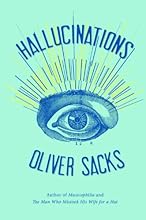Hallucinations
>> Sunday, November 4, 2012
 Have you ever seen something that wasn’t really there? Heard someone call your name in an empty house? Sensed someone following you and turned around to find nothing?
Have you ever seen something that wasn’t really there? Heard someone call your name in an empty house? Sensed someone following you and turned around to find nothing?Hallucinations don’t belong wholly to the insane. Much more commonly, they are linked to sensory deprivation, intoxication, illness, or injury. People with migraines may see shimmering arcs of light or tiny, Lilliputian figures of animals and people. People with failing eyesight, paradoxically, may become immersed in a hallucinatory visual world. Hallucinations can be brought on by a simple fever or even the act of waking or falling asleep, when people have visions ranging from luminous blobs of color to beautifully detailed faces or terrifying ogres. Those who are bereaved may receive comforting “visits” from the departed. In some conditions, hallucinations can lead to religious epiphanies or even the feeling of leaving one’s own body.
Humans have always sought such life-changing visions, and for thousands of years have used hallucinogenic compounds to achieve them. As a young doctor in California in the 1960s, Oliver Sacks had both a personal and a professional interest in psychedelics. These, along with his early migraine experiences, launched a lifelong investigation into the varieties of hallucinatory experience.
Here, with his usual elegance, curiosity, and compassion, Dr. Sacks weaves together stories of his patients and of his own mind-altering experiences to illuminate what hallucinations tell us about the organization and structure of our brains, how they have influenced every culture’s folklore and art, and why the potential for hallucination is present in us all, a vital part of the human condition.
About the author
Oliver Sacks was born in 1933 in London, England into a family of physicians and scientists (his mother was a surgeon and his father a general practitioner). He earned his medical degree at Oxford University (Queen’s College), and did residencies and fellowship work at Mt. Zion Hospital in San Francisco and at UCLA. Since 1965, he has lived in New York, where he is a practicing neurologist. From 2007 to 2012, he served as a Professor of Neurology and Psychiatry at Columbia University Medical Center, and he was also designated the university’s first Columbia University Artist. Dr. Sacks is currently a professor of neurology at the NYU School of Medicine, where he practices as part of the NYU Comprehensive Epilepsy Center.
In 1966 Dr. Sacks began working as a consulting neurologist for Beth Abraham Hospital in the Bronx, a chronic care hospital where he encountered an extraordinary group of patients, many of whom had spent decades in strange, frozen states, like human statues, unable to initiate movement. He recognized these patients as survivors of the great pandemic of sleepy sickness that had swept the world from 1916 to 1927, and treated them with a then-experimental drug, L-dopa, which enabled them to come back to life. They became the subjects of his book Awakenings, which later inspired a play by Harold Pinter (“A Kind of Alaska”) and the Oscar-nominated feature film (“Awakenings”) with Robert De Niro and Robin Williams.
He has investigated the world of Deaf people and sign language in Seeing Voices, and a rare community of colorblind people in The Island of the Colorblind. He has written about his experiences as a doctor in Migraine and as a patient in A Leg to Stand On. His autobiographical Uncle Tungsten: Memories of a Chemical Boyhood was published in 2001, and his most recent books are Musicophilia: Tales of Music and the Brain (2007), The Mind’s Eye (2010), and Hallucinations (2012).

Amazon's editors selected this title as one of the Best Books of the Month.
Available Formats:
- Hardcover
- Kindle book
- Audio, CD, Audiobook, Unabridged
- Paperback




0 comments:
Post a Comment